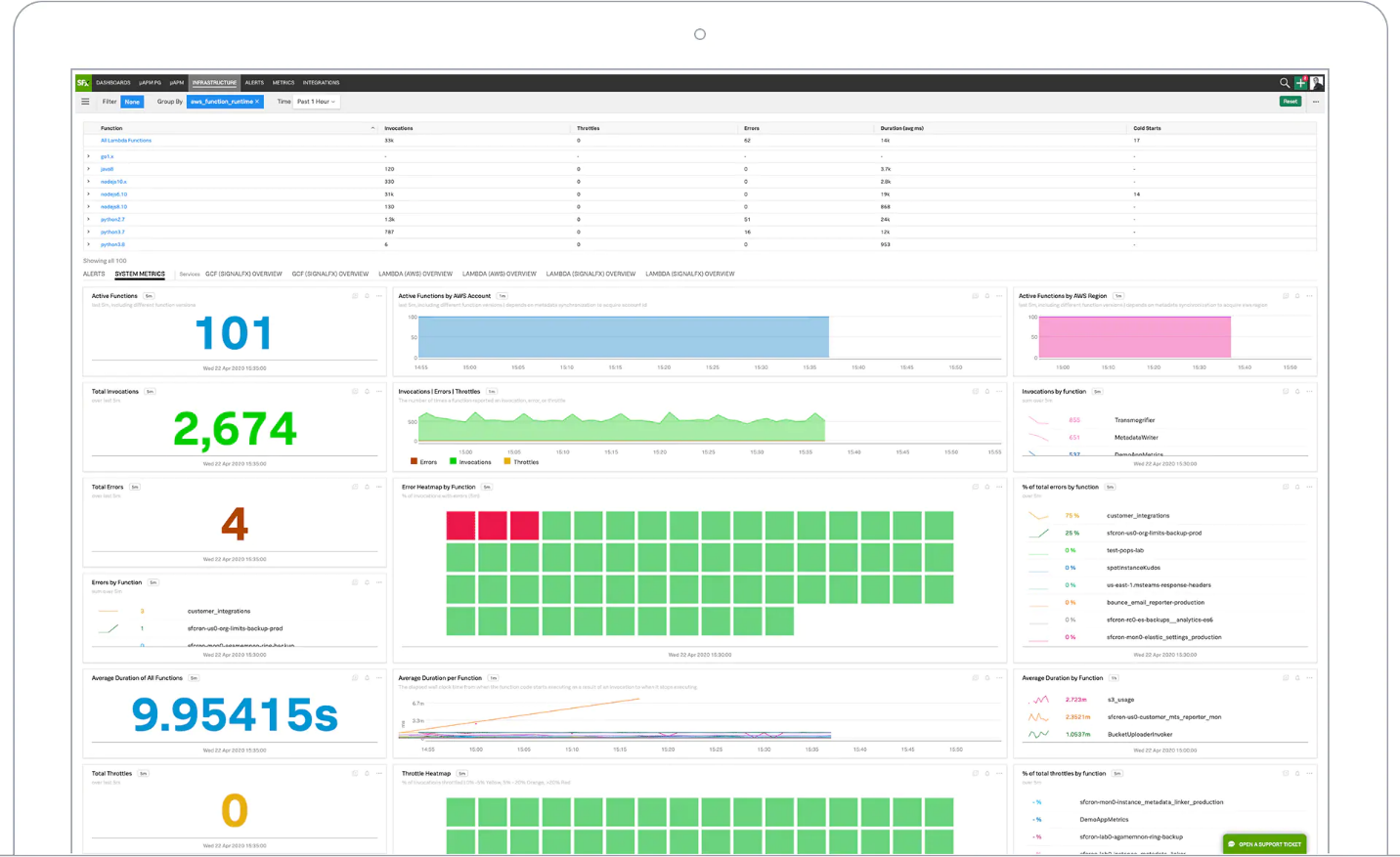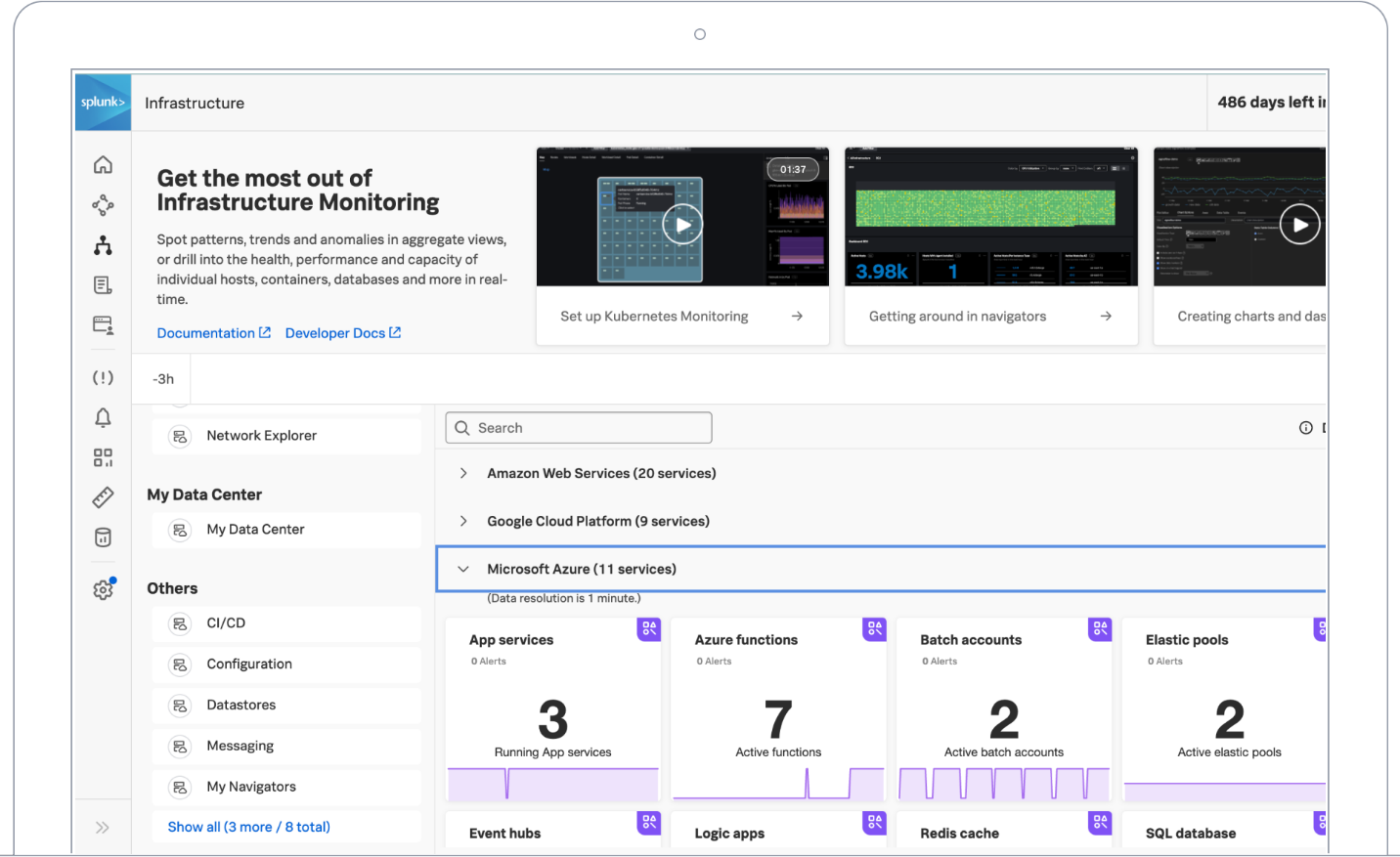Unveiling the Power of Splunk Infrastructure Monitoring: A Comprehensive Guide

Audio : Listen to This Blog.
In today’s digital landscape, where businesses rely heavily on complex infrastructures to deliver seamless services, monitoring and managing these infrastructures have become paramount. Splunk Infrastructure Monitoring offers a comprehensive solution to monitor, troubleshoot, and optimize your entire infrastructure ecosystem. From servers to networks and applications to cloud environments, it provides insights that empower organizations to make informed decisions, enhance performance, and ensure reliability.
Splunk monitoring cloud provides full-stack observability and deep data insights across hybrid and multi-cloud environments. In this article, we’ll delve into the intricacies of infrastructure monitoring, exploring its features, benefits, implementation, and real-world applications.
From Observability to Instant Alerts
Splunk Monitoring is a unified monitoring platform designed to provide real-time visibility into the health and performance of your IT infrastructure. It aggregates data from various sources, including servers, applications, containers, and cloud services, allowing organizations to gain actionable insights across their entire environment. Leveraging advanced analytics and machine learning capabilities, Splunk Monitoring helps detect anomalies, predict issues, and facilitate proactive problem resolution. As a vital component, it offers integrations and functionalities that enhance its monitoring capabilities within the broader ecosystem of Splunk observability.
From Observability to Instant Alerts

Source: Splunk
Key Features and Capabilities
Comprehensive Data Collection: Splunk Infrastructure Monitoring employs robust data collection mechanisms to gather information from diverse sources such as logs, metrics, and traces. This comprehensive approach provides a holistic view of your infrastructure’s health and performance, allowing for deep insights into system behavior and trends.
Full-stack Observability: Splunk Infrastructure Monitoring monitors critical metrics and indicators through real-time monitoring capabilities. This enables organizations to swiftly detect anomalies or deviations from expected performance levels, empowering them to take immediate corrective actions and prevent potential disruptions or downtime.

Source: Splunk
Customizable Dashboards: Splunk Infrastructure Monitoring offers a highly customizable dashboarding interface that allows users to tailor visualizations and displays according to their specific needs and preferences. This flexibility enables stakeholders to create personalized views focusing on the most relevant metrics and KPIs, enhancing situational awareness and decision-making.
Anomaly Detection: Leveraging advanced machine learning algorithms, Splunk Infrastructure Monitoring analyzes incoming data streams to identify patterns indicative of abnormal behavior. By detecting anomalies in real-time, the platform enables proactive resolution of potential issues before they escalate, thus ensuring continuous operational stability and performance.
Alerting and Notification: Splunk Infrastructure Monitoring provides robust alerting mechanisms that promptly notify relevant stakeholders about critical events or performance deviations. Alerts can be configured to trigger notifications via various channels, including email, SMS, and integration with collaboration tools, ensuring timely awareness and response to emerging issues. Furthermore, it enables users to take immediate action in response to alerts, leveraging its sophisticated analytics functions for problem detection and resolution.
Scalability: One of Splunk Infrastructure Monitoring’s core strengths is its ability to scale to meet the needs of growing infrastructures seamlessly. The platform can handle increasing data volumes and complexity without compromising performance or reliability, whether monitoring a few servers or a large-scale distributed environment.
Integration Capabilities: Splunk Infrastructure Monitoring boasts extensive integration capabilities, allowing it to seamlessly connect with a wide range of third-party tools and technologies. This interoperability facilitates seamless workflow orchestration and data correlation across disparate systems, enabling organizations to derive deeper insights and streamline operational processes.
Benefits of Real-Time Splunk Infrastructure Monitoring
Improved Performance: Splunk Infrastructure Monitoring empowers organizations to optimize resource utilization, enhance application responsiveness, and deliver superior user experiences by providing real-time insights into infrastructure performance. By analyzing critical metrics and performance indicators, organizations can fine-tune their systems for optimal efficiency and responsiveness, ensuring an enhanced user experience and maximizing available resources.
Reduced Downtime: Through proactive issue detection and rapid troubleshooting, Splunk Infrastructure Monitoring minimizes downtime and ensures continuous availability and reliability of critical services. By identifying and addressing potential issues before they escalate into full-blown outages, organizations can maintain uninterrupted operations and mitigate the impact of downtime on business operations and customer satisfaction.
Cost Optimization: Splunk Infrastructure Monitoring aids organizations in reducing operational costs and maximizing ROI on IT investments by identifying inefficiencies and optimizing resource utilization. By analyzing usage patterns and performance metrics, organizations can identify areas of overspending or underutilization, enabling them to rationalize their infrastructure investments and achieve cost savings without compromising performance or reliability.
Enhanced Security: With its comprehensive monitoring and threat detection capabilities, Splunk Infrastructure Monitoring strengthens security postures by helping organizations identify and mitigate potential security threats in real time. By continuously monitoring for suspicious activities, anomalous behavior, and security incidents, the platform enables organizations to proactively respond to security threats and prevent potential breaches, safeguarding sensitive data and ensuring compliance with regulatory requirements.
Streamlined Operations: Splunk Infrastructure Monitoring facilitates centralized monitoring and management, streamlining IT operations and enabling teams to identify, prioritize, and address issues efficiently. By providing a unified view of infrastructure health and performance, the platform allows teams to pinpoint the root causes of problems quickly, allocate resources effectively, and optimize operational workflows, improving overall efficiency and productivity across the organization.
Implementation of Splunk Infrastructure Monitoring

Implementing Splunk Infrastructure Monitoring involves several steps:
Assessment and Planning: Before implementing Splunk Infrastructure Monitoring, you must thoroughly evaluate your infrastructure requirements and objectives. This involves assessing factors such as the size and complexity of your environment, the criticality of your systems and applications, and the performance metrics most relevant to your organization. By understanding your monitoring needs and objectives, you can determine the scope and scale of monitoring required to manage your infrastructure effectively.
Deployment: Once you have assessed your monitoring requirements, the next step is to deploy Splunk Infrastructure Monitoring agents across your infrastructure. These agents collect data from various sources, including servers, applications, networks, and cloud services, ensuring comprehensive coverage of your entire environment. By deploying agents strategically across your infrastructure, you can ensure that all critical components are monitored effectively, enabling you to gain insights into the health and performance of your systems and applications.
Configuration: After deploying Splunk Infrastructure Monitoring agents, it is essential to configure monitoring policies, alerts, and dashboards based on your organization’s specific needs and priorities. This involves defining which metrics and performance indicators are most important to monitor, setting thresholds for alerting, and customizing dashboards to visualize key metrics and trends. By tailoring the configuration of Splunk Infrastructure Monitoring to align with your organization’s objectives, you can focus on the most critical aspects of your infrastructure and optimize the platform for maximum effectiveness.
Integration: Splunk Infrastructure Monitoring offers extensive integration capabilities, allowing you to integrate it with other tools and systems within your environment seamlessly. This enables you to facilitate seamless data exchange and correlation and derive more profound insights into your infrastructure’s health and performance. By integrating Splunk Infrastructure Monitoring with your existing monitoring and management tools, you can leverage the strengths of each platform and create a unified monitoring ecosystem that provides comprehensive visibility and actionable intelligence.
Training and Adoption: To ensure the successful adoption of Splunk Infrastructure Monitoring, it is essential to provide training to relevant stakeholders within your organization. This includes administrators responsible for configuring and managing the platform and end-users who will be using the platform to monitor and analyze infrastructure performance. By providing comprehensive training and support, you can empower your team to make the most of Splunk Infrastructure Monitoring and maximize its benefits. Also, fostering a continuous learning and improvement culture will ensure that your organization continues to derive value from the platform as your infrastructure and monitoring needs evolve.
Real-world Applications

Splunk Infrastructure Monitoring finds applications across various industries and use cases:
E-commerce: In the e-commerce sector, Splunk Infrastructure Monitoring plays a crucial role in monitoring the performance of online platforms. By continuously analyzing key metrics such as website load times, transaction processing speeds, and server response rates, organizations can ensure optimal user experience for customers.
Finance: Within the finance industry, Splunk Infrastructure Monitoring is instrumental in monitoring critical financial systems to detect anomalies and ensure compliance with regulatory requirements. Organizations can detect and investigate suspicious activities indicative of potential security threats or compliance violations by monitoring transaction processing times, database access patterns, and system access logs.
Healthcare: In the healthcare sector, Splunk Infrastructure Monitoring plays a vital role in ensuring the availability and reliability of electronic health records (EHR) systems, medical devices, and patient portals. By monitoring system uptime, network connectivity, and application performance, organizations can ensure uninterrupted access to critical healthcare services for patients and healthcare providers.
Telecommunications: Within the telecommunications industry, Splunk Infrastructure Monitoring is essential for monitoring network performance and availability to ensure seamless connectivity and enhance customer satisfaction. Organizations can identify and address performance issues impacting service quality or availability by monitoring key network metrics such as latency, packet loss, and bandwidth utilization.
Manufacturing: In the manufacturing sector, Splunk Infrastructure Monitoring is critical for monitoring industrial IoT devices and production systems to optimize operational efficiency and ensure product quality. By monitoring equipment performance, production line throughput, and inventory levels, organizations can identify opportunities for process improvement and cost optimization.
Conclusion
Splunk Infrastructure Monitoring is a comprehensive solution to address the evolving challenges of monitoring and managing modern IT infrastructures. By providing real-time insights, proactive issue detection, and actionable intelligence, Splunk Infrastructure Monitoring empowers organizations to optimize performance, enhance reliability, and drive business success in today’s dynamic digital landscape. With its robust features, scalability, and integration capabilities, Splunk Infrastructure Monitoring remains a cornerstone of effective infrastructure monitoring and management strategies across industries worldwide.
